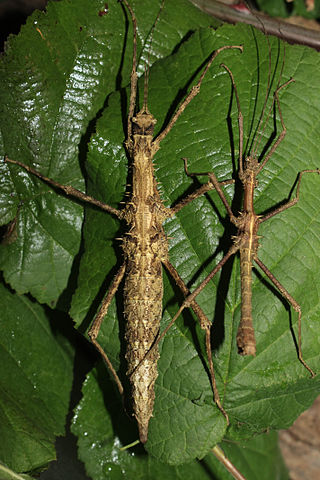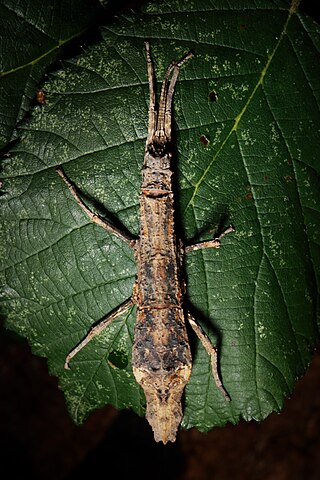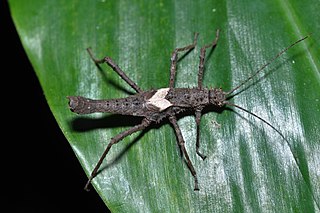
The genus Orestes combines relatively small and elongated Phasmatodea species from Southeast and East Asia.

Orestes draegeri is a species of stick insects in the subfamily Dataminae and tribe Datamini.

The genus Microrestes combines relatively small and squat Phasmatodea species from continental Southeast Asia and South China.

Orestes dittmari is a species of stick insects in the subfamily Dataminae.

Obrimus is a stick insect genus native to the Philippines. It is type genus for the tribe and the subfamily in which it is listed.

Orestes bachmaensis is a Phasmatodea species native to central Vietnam.

Orestes guangxiensis is a representative of the genus Orestes.

Orestes japonicus, a stick insect, is a representative of the genus Orestes.

Orestes subcylindricus is a species of stick insects native to Vietnam.

Pylaemenes elenamikhailorum is a species of stick insects native in Sepilok on Borneo. In application of the more recent differentiation between the genera Pylaemenes and Orestes the species is sometimes also called Orestes elenamikhailorum.
Orestes diabolicus is a species of stick insects native in Vietnam. The species is so far only known from a three males.
Orestes botot is a species of stick insects native in Vietnam.

Tisamenus clotho is a stick insect species native to the Philippines.

Pylaemenes konchurangensis is a species of stick insects native in Vietnam. The species has been described in the genus Pylaemenes, but from its morphological characters it belongs in the genus Orestes.

Microrestes robustus is a stick insect species native to northwestern Vietnam.

Haaniella parva is a species of stick insect from the subfamily Heteropteryginae and belongs to the representatives of the genus Haaniella native to Sumatra. It is their smallest representative.

Trachyaretaon bresseeli is a species of stick insects in the family Heteropterygidae. It is native to the Philippine island Luzon.

Sungaya ibaloi is a species of insect from the family Heteropterygidae. It is one of three very similar stick insect species of the genus Sungaya, which are often kept in the terrariums of enthusiasts. Like all representatives of the genus, the species is endemic to the Philippine island Luzón and was found there in the province of Benguet.

Eubulides timog is a stick insect species from the family of the Heteropterygidae. Although only described in 2023, this species, native to the south and east of the Philippine island Luzón, has been kept and bred in the terrariums of enthusiasts since 2009.

Eubulides igorrote is a stick insect species from the family of the Heteropterygidae native to the Philippine island of Luzon.






















